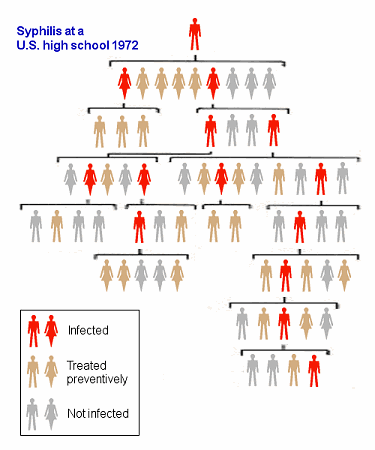|
5.5.2 SYPHILIS
|
Source: Newsweek, Jan. 24, 1972 |
When antibiotic treatments were introduced in the late 1940s, the STD rates in the U.S. declined very dramatically. However, after the drastic cut of governmental prevention programs, the infection rates rose once more. By the early 1970s, they had risen to new heights. How easily STDs can spread, is illustrated by the diagram on the left, taken from a 1972 popular magazine. Shown here is the spread of syphilis in one American high school. Each figure represents at least one sexual contact. Some 40% of the students exposed did not become infected. How many of those treated preventively may have been infected is unknown. Please, note that syphilis is spread by both hetero- and homosexual contact. In the diagram, the total number of individuals is 63. Of these, 44 had only heterosexual contact, 16 had only homosexual contact, and 3 had both heterosexual and homosexual contact.
|
|
Syphilis (or lues), also popularly known as "the siff" or "bad blood", is the most dangerous venereal disease. Although it is not nearly as common as gonorrhea, it is by no means rare. Syphilis is caused by a bacterial organism, the spirochete, which is transmitted from one person to another through intimate physical contact, particularly the touching together of the moist inner body surfaces during sexual intercourse. Outside the human body, the spirochete cannot survive more than a few seconds. It is therefore practically impossible to contract syphilis from toilet seats, bath tubs, towels, bed linens, or other such objects. Neither can the disease be transmitted through the intact skin. However, the spirochete, which may be present in the mucous membranes, the saliva, semen, or blood of an infected person, can enter any cut or even slight skin abrasion of his sexual partner.
Symptoms
The first symptom of a syphilitic infection is a painless ulcer or sore (chancre) which appears within ten to ninety days at the point where the spirochele entered the body. Depending on the kind of sexual intercourse, this can he anywhere: on or near the sex organs, the mouth, the rectum, or some other area. The ulcer may be large and obvious or small and hardly noticeable. If it should appear inside the vagina or rectum, it might easily go undetected. Unfortunately, sometimes there is no outward symptom at all. In any case, the ulcer heals itself after a while. An infected person may thus gain the false impression that he is cured. In reality, however, the disease has now entered its second stage.
At the second stage of syphilis, the spirochetes have entered the bloodstream and thus spread through the whole body. The result is a rash, which usually appears 3-6 weeks after infection. This rash may take almost any form and may cover a small or large surface of the skin, in some cases, no rash may appear at all. Both the rash and the primary ulcer are infectious. There may also be a loss of patches of hair.
After the rash has disappeared, the disease enters its third stage which may last from a few months to several years. There may be no symptoms at all for quite a long time. However, this stage is the most dangerous of all because the disease may now suddenly attack various areas inside the body, destroying normal tissue and causing serious heart disease, blindness, paralysis, brain damage, and even death.
Syphilis can be transmitted to a baby before its birth through the mother's bloodstream. Because of this danger, expectant mothers need to have a blood test for syphilis early in the pregnancy.
Diagnosis
A diagnosis of syphilis can be made only by a doctor, usually by means of a blood test.
Treatment
Syphilis is a very dangerous disease which requires the earliest possible treatment. Fortunately, it is easily curable today, although any damage that has occurred before treatment is started cannot be repaired. The usual treatment consists of a series of penicillin shots. Occasionally, some other medication may be indicated. In order to insure success, follow-up blood tests are necessary. Successful treatment does not result in immunity. A person may catch syphilis again and again.
Prevention
The only certain way to protect oneself against syphilis is to avoid sexual intercourse with an infected partner. However, since there may be no noticeable symptoms and people may therefore have the disease without knowing it, the best advice for any sexually active person is to have regular blood tests (one every 3-6 weeks). Such tests, together with proper treatment (where necessary), are offered free by public health clinics in most cities.
Wearing a condom during genital or anal intercourse and urinating and washing with soap and water immediately afterwards also offer at least partial protection, as will the use of vaginal contraceptive foams or jellies.
|

